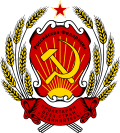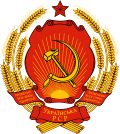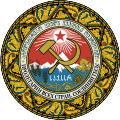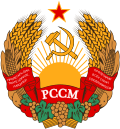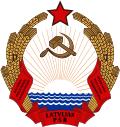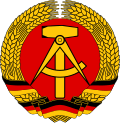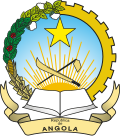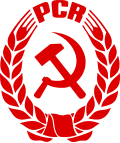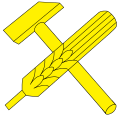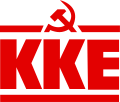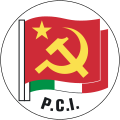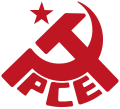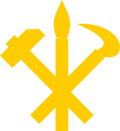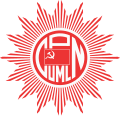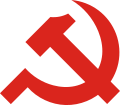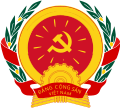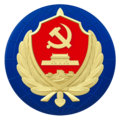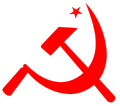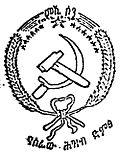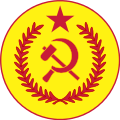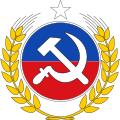Hammer and sickle
Symbol of communism From Wikipedia, the free encyclopedia
The hammer and sickle (Unicode: U+262D ☭ HAMMER AND SICKLE) is a communist symbol representing proletarian solidarity between agricultural and industrial workers. It was first adopted during the Russian Revolution at the end of World War I, the hammer representing workers and the sickle representing the peasants.[1]
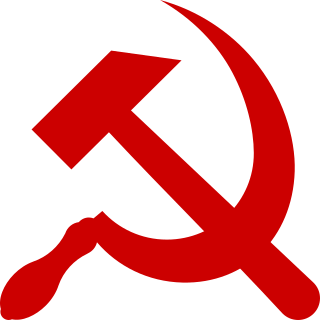
After World War I (from which Russia withdrew in 1917) and the Russian Civil War, the hammer and sickle became more widely used as a symbol for labor within the Soviet Union (USSR) and for international proletarian unity. It was taken up by many communist movements around the world, some with local variations. The hammer and sickle remains commonplace in self-declared socialist states, such as China, Cuba, North Korea, Laos, and Vietnam, but also some former Soviet republics following the dissolution of the Soviet Union, such as Belarus and Russia. Some countries have imposed bans on communist symbols, where the display of the hammer and sickle is prohibited.
History
Summarize
Perspective
The Chilean peso coin used the hammer and sickle symbol over a wreath between 1894 and 1940, as designed by Louis-Oscar Roty.
Worker symbolism
One example of use prior to its political instrumentalization by the Soviet Union is found in Chilean currency circulating since 1894.[2][3]
Inception
In 1918, Yevgeny Ivanovich Kamzolkin proposed a 'hammer and sickle' symbol as a decoration for the May Day celebrations in the Zamoskvorechye District of Moscow.[4][5] It originally featured a sword, but Lenin strongly objected, disliking the militaristic connotations.[6][7] On 6 July 1923, the 2nd session of the Central Executive Committee (CIK) adopted the emblem.[6][failed verification]
In 1919, the new Republic of Austria introduced a sickle and a hammer to its coat of arms, one in each talon of its supporting eagle, to represent the farming and industrial classes. They were removed in 1934 with the establishment of the Fascist Federal State of Austria and returned in 1945 after the defeat of Nazi Germany (which had absorbed Austria in 1938) in the Second World War.
In his work, Daily Life in a Crumbling Empire: The Absorption of Russia into the World Economy, sociologist David Lempert hypothesizes that the hammer and sickle was a secular replacement for the patriarchal cross.[8][9]
Use in Soviet Union


- The State Emblem of the Soviet Union and the Coats of Arms of the Soviet Republics showed the hammer and sickle, which also appeared on the red star badge on the uniform cap of the Red Army uniform and in many other places.
- Serp i Molot (transliteration of Russian: cерп и молот, "sickle and hammer") is the name of the Moscow Metallurgical Plant.
- Serp i Molot is also the name of a stop on the electric railway line from Kurski railway station in Moscow to Gorky, featured in Venedikt Yerofeyev's novel, Moscow-Petushki.
Meaning
At the time of creation, the hammer and sickle stood for worker-peasant alliance, with the hammer a traditional symbol of the industrial proletariat (who dominated the proletariat of Russia) and the sickle a traditional symbol for the peasantry, but the meaning has since broadened to a globally recognizable symbol for Marxism, communist parties, or socialist states.[6]
Current usage
Summarize
Perspective
Post-Soviet states
Two federal subjects of the post-Soviet Russian Federation use the hammer and sickle in their symbols: the Vladimir Oblast has them on its flag and the Bryansk Oblast has them on its flag and coat of arms, which is also the central element of its flag. In addition, the Russian city of Oryol also uses the hammer and sickle on its flag.[citation needed]
The former Soviet (now Russian) national airline, Aeroflot, continues to use the hammer and sickle in its symbol.[10]
The de facto government of Transnistria uses (with minor modifications) the flag and the emblem of the former Moldavian SSR, which includes the hammer and sickle. The flag can also appear without the hammer and sickle in some circumstances, for example on Transnistrian-issued license plates.[citation needed]
Communist parties
Three out of the five currently ruling Communist parties use a hammer and sickle as the party symbol: the Chinese Communist Party, the Communist Party of Vietnam and the Lao People's Revolutionary Party. In Laos and Vietnam, the hammer and sickle party flags can often be seen flying side by side with their respective national flags.[citation needed]
Many communist parties around the world also use it, including the Communist Party of Greece,[11] the Communist Party of Argentina, the Communist Party of Chile, both the Communist Party of Brazil and the Brazilian Communist Party, the Purba Banglar Sarbahara Party from Bangladesh, the Communist Party of Sri Lanka, the Communist Party of India (Marxist), the Communist Party of India (Marxist–Leninist) Liberation, the Communist Party of India, the Communist Party of India (Maoist), the Indian Communist Marxist Party, the Socialist Unity Centre of India (Communist), the Egyptian Communist Party, the Communist Party of Pakistan, the Communist Refoundation Party in Italy, the Communist Party of Spain, the Communist Party of Denmark, the Communist Party of Norway, the Romanian Communist Party, the Lebanese Communist Party, the Communist Party of the Philippines and the Shining Path. The Communist Party of Sweden, the Portuguese Communist Party[12] and the Mexican Communist Party use the hammer and sickle imposed on the red star.
Variations
Summarize
Perspective
Many symbols having similar structures and messages to the original have been designed. For example, the Angolan flag shows a segment of a cog, crossed by a machete and crowned with a socialist star, while the flag of Mozambique features an AKM crossed by a hoe. In the logo of the Communist Party USA, a circle is formed by a half cog and a semicircular sickle-blade. A hammer is laid directly over the sickle's handle, with the hammer's head at the logo's center. The logo of the Communist Party of Turkey consists of half a cog wheel crossed by a hammer, with a star on the top.[13]
Tools represented in other designs include: the brush, sickle and hammer of the Workers' Party of Korea; the spade, flaming torch and quill used prior to 1984 by the British Labour Party; the pickaxe and rifle used in communist Albania; and the hammer and compasses of the East German emblem and flag. The Far Eastern Republic of Russia used an anchor crossed over a spade or pickaxe, symbolising the union of the fishermen and miners. The Fourth International, founded by Leon Trotsky, uses a hammer and sickle symbol on which the number 4 is superimposed. The hammer and sickle in the Fourth International symbol are the opposite of other hammer and sickle symbols in that the head of the hammer is on the right side and the sickle end tip on the left. The Trotskyist League for the Fifth International merges a hammer with the number 5, using the number's lower arch to form the sickle. A sickle with a rifle is also used by the People's Mojahedin of Iran.
The Communist Party of Britain uses the hammer and dove symbol. Designed in 1988 by Michal Boncza, it is intended to highlight the party's connection to the peace movement. It is usually used in conjunction with the hammer and sickle, and it appears on all of the CPB's publications. Some members of the CPB prefer one symbol over the other, although the party's 1994 congress reaffirmed the hammer and dove's position as the official emblem of the party. Similarly, the Communist Party of Israel uses a dove over the hammer and sickle as its symbol. The flag of the Guadeloupe Communist Party uses a sickle, turned to look like a majuscule G, to represent Guadeloupe.[14]
In 1938, the Dobama Asiayone, an anti-British nationalist group in the then British Burma, adopted a tricolour flag charged with a red sickle and hammer.[15] From 1974–2010, the flag of Burma (Myanmar) featured a bushel of rice superimposed on a cogwheel surrounded by fourteen white stars; the rice representing the peasants and the cogwheel representing the workers, the combination symbolizing that the peasants and workers be the two basic social classes for State building, while the fourteen equal-sized white stars indicate the unity and equality of fourteen member states of the Union.[16]
The flag of Chama Cha Mapinduzi (CCM, Party of the Revolution in Swahili), currently the ruling political party of Tanzania, has a slightly different symbol with a hammer and a hoe (jembe) instead of a sickle to represent the most common farm tool in Africa.[citation needed]
The symbols of the liberal socialist parties of Radical Civic Union in Argentina and the Czech National Social Party in the Czech Republic feature a hammer and a quill, with the former representing workers and the latter representing clerks.[citation needed]
The election symbol of the Communist Party of India consists of a horizontal sickle, vertically crossed by Ears of Corn in the center.
Art
The hammer and sickle has long been a common theme in socialist realism, but it has also seen some depiction in non-Marxist popular culture. Andy Warhol who created many drawings and photographs of the hammer and sickle is the most famous example of this.
- The metro station, Plošča Lienina, Minsk
- Sándor Pinczehelyi, Hammer and Sickle
- The Hoof and Horn flag described in the book Animal Farm is a parody of the hammer and sickle.
Legal status
Summarize
Perspective
In several countries in the former Eastern Bloc, there are laws that define the hammer and sickle as the symbol of a "totalitarian and criminal ideology" and the public display of the hammer and sickle and other Communist symbols such as the red star is considered a criminal offence. Georgia,[17] Hungary,[18] Latvia,[19] Lithuania,[20] Moldova (1 October 2012 – 4 June 2013)[21] and Ukraine[22][23][24] have banned communist symbols including this one. A similar law was considered in Estonia,[25] but it eventually failed in a parliamentary committee.[26] In Ukraine, the legislature equates communist symbols including hammer with sickle to Nazi swastika symbols.[27][28]
In 2010, the Lithuanian, Latvian, Bulgarian, Hungarian, Romanian, and Czech governments called for the European Union to criminalize "the approval, denial or belittling of communist crimes" similar to how a number of EU member states have banned Holocaust denial. The European Commission turned down this request, finding after a study that the criteria for EU-wide criminal legislation were not met, leaving individual member states to determine the extent to which they wished to handle past totalitarian crimes.[29]
In February 2013, the Constitutional Court of Hungary annulled the ban on the use of symbols of fascist and communist dictatorships, including the hammer and sickle, the red star and the swastika, saying the ban was too broad and imprecise. The court also pointed to a judgement of the European Court of Human Rights in which Hungary was found guilty of violation of article 10, the right to freedom of expression.[30] In June 2013, the Constitutional Court of Moldova ruled that the Moldovan Communist Party's symbols—the hammer and sickle—are legal and can be used.[31]
In Indonesia, the display of communist symbols is banned and the country's Communist party was also banned by decree of president Suharto, following the 1965–1966 killings of communists in which over 500,000 people were killed.[32][33] In January 2018, an activist protesting against Bumi Resources displayed the hammer and sickle, was accused of spreading communism, and later jailed.[34][35]
In Poland, dissemination of items which are "media of fascist, communist or other totalitarian symbolism" was criminalized in 1997. However, the Constitutional Tribunal found this sanction to be unconstitutional in 2011.[36]
Usage
Flags
Europe and Russia/Soviet Union
- Flag of the Soviet Union from 1922 to November 1923
- Flag of the Soviet Union from November 1923 to April 1924
- Flag of the Soviet Union from April 1924 to December 1936
- Flag of the Soviet Union from December 1936 to 1955
- Flag of the Soviet Union from 19 August 1955 to 26 December 1991
- Naval Jack of the Soviet Union and Russia from 16 November 1950 to 26 July 1992
- Naval ensign of the Soviet Union and Russia from 16 November 1950 to 26 July 1992
- Flag of Aeroflot from 1961 to 1991
- Flag of the Russian SFSR from 1954 to 1991
- Flag of the Ukrainian SSR from 1950 to 1992
- Flag of the Byelorussian SSR from 1951 to 1991
- Flag of the Uzbek SSR from 1952 to 1991
- Flag of the Kazakh SSR from 1953 to 1992
- Flag of the Georgian SSR from 1951 to 1990
- Flag of the Azerbaijani SSR from 1956 to 1991
- Flag of the Lithuanian SSR from 1953 to 1988
- Flag of the Moldavian SSR from 1952 to 1990
- Flag of the Latvian SSR from 1953 to 1990
- Flag of the Kirghiz SSR from 1952 to 1992
- Flag of the Tajik SSR from 1953 to 1991
- Flag of the Armenian SSR from 1952 to 1990
- Flag of the Turkmen SSR from 1953 to 1992
- Flag of the Estonian SSR from 1953 to 1990
- Flag of the Karelo-Finnish SSR from 1953 to 1956
- Flag of the Communist Party of the Donetsk People's Republic
- Flag of the Romanian Communist Party
- Flag of the Communist Party of the Russian Federation
- Flag of the Communists of Russia
- Flag of Bryansk Oblast (Russia)
- Flag of Vladimir Oblast (Russia)
- Flag of Oryol (Russia)
- Flag of Transnistria (Moldova)
- Flag of the National Bolshevik Party
- Flag of the Communist Party of Germany
- Reverse side of the Communist Party of Germany flag
- Flag of East Germany from 1959 to 1990
- Flag of the Communist Party of Greece
- Flag of the Italian Communist Party
- Flag of the Communist Refoundation Party (Italy)
- Flag of the Communist Party of Ireland
- Flag of the Portuguese Communist Party
- Flag of the Sammarinese Communist Party
- Flag of the Maoist Communist Party (Turkey)
- Flag of the Revolutionary People's Liberation Party–Front (Turkey)
- Flag of the Communist Party of Britain
- Flag of the League of Communists of Yugoslavia
Asia minus Russia/Soviet Union
- Flag of the Vietnamese Communist Party
- Flag of the Chinese Communist Party
- Flag of the Chinese Communist Party (before 1996)
- Flag of the Taiwan Democratic Communist Party
- Flag of the Chinese Soviet Republic (1931–1937)
- Flag of the Workers' Party of Korea
- Flag of the Communist Party of India
- Flag of the Communist Party of India (Marxist)
- Flag of various South Asian communist parties, including the Communist Party of India (Maoist)
- Flag of the Socialist Unity Centre of India
- Flag of the Communist Party of Bangladesh
- Flag of the Nepal Communist Party
- Flag of Communist Party of Indonesia
- Flag of the Socialist Party of Timor
- Flag of the Communist Party of the Philippines
- Flag of the Lao People's Revolutionary Party
- Flag of the Communist Party of Kampuchea
- Flag of the Malayan Communist Party (1930–1989)
- Flag of the Lebanese Communist Party
- Flag of the Syrian Communist Party (Bakdash)
- Flag of the Kurdistan Workers' Party (1978–1995)
- Flag of the Jordanian Communist Party
- Flag of the Palestinian Communist Party
Africa
- Flag of the Algerian Communist Party
- Flag of FRELIMO (1987–2004)
- Flag of the People's Republic of the Congo and the Congolese Party of Labour
- Flag of the Workers' Party of Ethiopia
- Flag of the Communist Party of Kenya
- Flag of the South African Communist Party
- Flag of the Communist Party of Swaziland
Americas
- Flag of the PCCE
- Flag of the PCB
- Flag of the PCdoB
- Flag of the Workers' Cause Party (Brazil)
- Flag of the Communist Party of Chile
- Flag of the Communist Party of Ecuador
- Flag of the Shining Path (Peru)
- Flag of the Communist Party USA
- Flag of the Revolutionary Communist Party (Argentina)
State emblems
Soviet Union (in the constitutional order)
- Emblem of the Russian Federation (1992‒1993)
Other
- National emblem of the German Democratic Republic (1955–1990)
- State emblem of the Tuvan People's Republic (1943‒1944)
- Emblem of the self-proclaimed Pridnestrovian Moldavian Republic
- State emblem of the Lao People's Democratic Republic (1975‒1991)
- Emblem of the People's Republic of the Congo (1970–1991)
- State emblem of the Chinese Soviet Republic (1934–1937)
- Emblem of Hungarian People's Republic (1949–1956)
- Emblem of Moscow (1924–1937)
- Coat of arms of Bryansk Oblast, Russia
Logos
Europe
- The hammer and sickle symbol used with the red star used as a symbol of Soviet Union.
- Badge of the Communist Party of the Soviet Union
- Emblem of the Communist Party of Czechoslovakia
- Emblem of the Romanian Communist Party
- Logo of the Bulgarian Communist Party
- Compass and hammer of East Germany.
- Hammer and grain of the Hungarian People's Republic
- Emblem of the League of Communists of Yugoslavia
- Logo of the Communist Party of the Russian Federation
- Logo of the Communist Party of Greece
- Logo of the Italian Communist Party
- Logo of the Proletarian Unity Party (Italy)
- Logo of the Communist Party (Italy)
- Logo of the Communist Party of Spain
- Logo of the Communist Party of the Peoples of Spain
- Logo of the Portuguese Communist Party
- Logo of the Communist Party of Ireland
- Logo of the French Communist Party (1980‒1996)
- Logo of the Communist Party of Britain
- Logo of the Communist Party (Sweden)
- The Logo of the Communist Party of Norway
- Logo of the Communist Party of Denmark
- Logo of the Communist Party (Denmark)
- Logo of the Communist Party of Germany
- Logo of the Communist Party (Switzerland)
- Logo of the New Communist Party of the Netherlands
- Logo of the Communist Party of Belgium (1989)
- Badge of the Marxist–Leninist Communist Party of Turkey
- Logo of the Revolutionary Communist Party of Turkey
- Logo of Aeroflot
- Logo of the Communist Party of Ireland (Marxist–Leninist)
- Symbol of the Group of Social Revolutionary Nationalists
Asia
- Emblem of the Workers' Party of Korea
- Emblem of the Communist Party of Indonesia (1914‒1966)
- Logo of the Acoma Party (Indonesia)
- Logo of the Communist Party of Tajikistan
- Logo of the Socialist Party of Bangladesh
- Logo of the Communist Party of Nepal (Unified Marxist–Leninist) (1991–2018)
- Emblem of the Communist Party of Vietnam
- Alternative emblem of the Communist Party of Vietnam
- Logo of the Ministry of State Security
- Emblem of the Chinese Communist Party (1942–1996)
- Emblem of the Chinese Communist Party (1996–present)
- Logo of the Lanka Sama Samaja Party, which features the symbol of the Fourth International
- Logo of the Communist Party of India
- Logo of the Communist Party of India (Marxist)
- Emblem of the Yemeni Socialist Party (1978-1990)
Africa
- Cogwheel, machete and star logo of Angola
- Logo of the Communist Party of Benin
- Logo of the Congolese Party of Labour
- Logo of the Egyptian Communist Party
- Flag of the Workers' Party of Ethiopia
- Emblem of the All-Ethiopia Socialist Movement
- Emblem of the Ethiopian People's Revolutionary Party (ca. 1975)
- Hammer and machete logo of the Revolutionary Communist Party of Ivory Coast
- Logo of the Communist Party of Kenya
- Logo of FRELIMO (Mozambique) (1987–2004)
- Emblem of the Somali Revolutionary Socialist Party
- Logo of the South African Communist Party
- Logo of the Workers' Party of Tunisia
Americas
- Logo of the Communist Party of Argentina
- Logo of the Brazilian Communist Party
- Logo of the Communist Party of Brazil
- Logo of the Workers' Cause Party
- Logo of the Communist Party of Chile
- Logo of the Communist Party of Ecuador
- Logo of the Mexican Communist Party
- Logo of the Paraguayan Communist Party
- Logo of the Shining Path
- Emblem of the Communist Party USA
Unicode
In Unicode, the "hammer and sickle" symbol is U+262D (☭). It is part of the Miscellaneous Symbols (2600–26FF) code block. It was added to Unicode 1.1 in 1993.[37]
See also
- Arm and hammer
- Fist and rose
- Communist symbolism
- Socialist heraldry
- Hammer and pick (⚒)
- Red flag (⚑)
- Red star (★)
- Transport and Map Symbols Unicode block (contains 🛠 "hammer and wrench" as U+1F6E0)
Notes
References
External links
Wikiwand - on
Seamless Wikipedia browsing. On steroids.




































































































